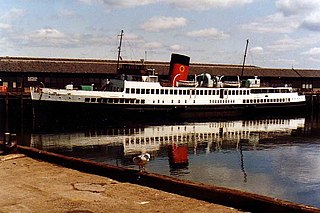
Ilfracombe is a seaside resort and civil parish on the North Devon coast, England, with a small harbour surrounded by cliffs.

The Clyde steamer is the collective term for several passenger services that existed on the River Clyde in Scotland, running from Glasgow downstream to Rothesay and other towns, a journey known as going doon the watter.
The SS Cornubia was laid down in November 1856 and built in Hayle, Cornwall, by Harvey & Co. She was launched in February 1858 as a packet ship and ferry for the Hayle and Bristol Steam Packet Company. Sleek and painted white, with two funnels mounted close together amidships and with a high bridge over her paddle wheels, she plied the Hayle/St Ives to Bristol route in the days when the Great Western Railway had not penetrated as far as West Cornwall.

MV Balmoral is a vintage excursion ship owned by MV Balmoral Fund Ltd., a preservation charity. Her principal area of operation is the Bristol Channel, although she also operates day excursions to other parts of the United Kingdom. The Balmoral is included on the National Historic Ships register as part of the National Historic Fleet.
The West Cornwall Steam Ship Company was established in 1870 to operate ferry services between Penzance, Cornwall, and the Isles of Scilly. It became the West Cornwall Steamship Company in 1907 and was wound up in 1917.

PS Ryde is a paddle steamer that was commissioned and run by Southern Railway as a passenger ferry between mainland England and the Isle of Wight from 1937 to 1969, with an interlude during the Second World War where she served as a minesweeper and then an anti-aircraft ship, seeing action at D-Day. After many years abandoned on moorings at Island Harbour Marina on the River Medina, she was purchased by the PS Ryde Trust in late 2018, with the intention of raising money for her restoration. That project was abandoned in January 2019.
PS Slieve Donard was a United Kingdom passenger paddle steamer that in different periods of her history was also called PS Albion and HMS Albyn. Albion is the name she bore the longest and may be the one by which she is better known in England. Slieve Donard was her original name and the one by which she will be best known on the island of Ireland.
The Hayle and Bristol Steam Packet Company operated steam ship services between Hayle, Ilfracombe and Bristol in the mid nineteenth century. Confusingly from 1848 to 1860, the company name was used by two separate operators.
PS Great Western was a passenger vessel built for Ford and Jackson in 1867 and then used by the Great Western Railway from 1872 to 1890.
PS South of Ireland was a passenger vessel built for Ford and Jackson in 1867 and then used by the Great Western Railway from 1872 to 1883.

PS Bristol Queen was a passenger excursion vessel built for P & A Campbell in 1946.

P & A Campbell was a shipping company based in Bristol which operated steamship services in the Bristol Channel between 1893 and 1979.
PS Lady Tyler was a passenger vessel built for the Great Eastern Railway in 1880.
PS Ipswich was a passenger vessel built for the Great Eastern Railway in 1864.
PS Killingholme was a passenger and cargo vessel built for the Great Central Railway in 1912.
PS Brocklesby was a passenger and cargo vessel built for the Great Central Railway in 1912.
PS Cleethorpes was a passenger and cargo vessel built for the Great Central Railway in 1903.
HMS Snaefell was a paddle steamer, built at John Brown & Company's Clydebank shipyard for the Barry Railway Company and launched in 1907 as the PS Barry. Built to serve as a pleasure steamer carrying passengers on the Bristol Channel, she was quickly transferred to the ownership of Bristol Channel Passenger Boats which in 1911 became part of P & A Campbell.
PS Waverley was a Clyde-built paddle steamer that carried passengers on the Clyde between 1885 and 1887, then on the Bristol Channel from 1887 until 1916, when she was requisitioned by the Admiralty to serve as a minesweeper during World War I.




